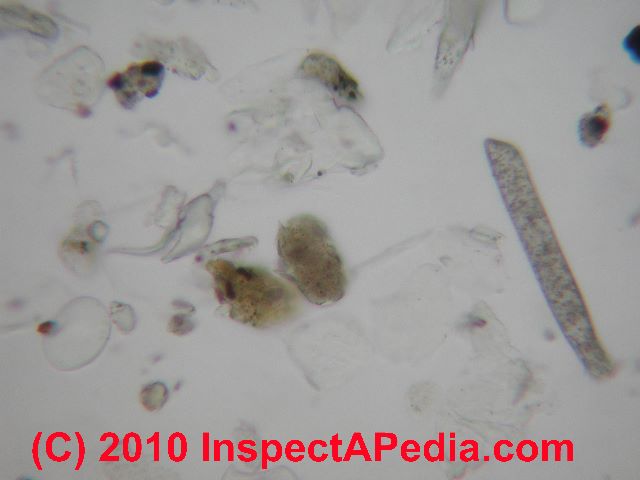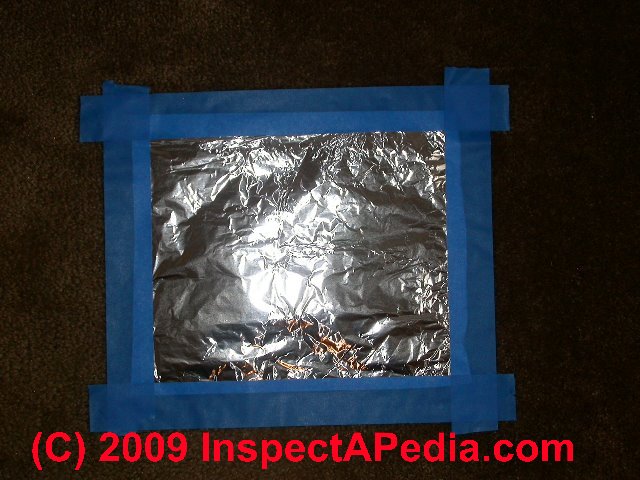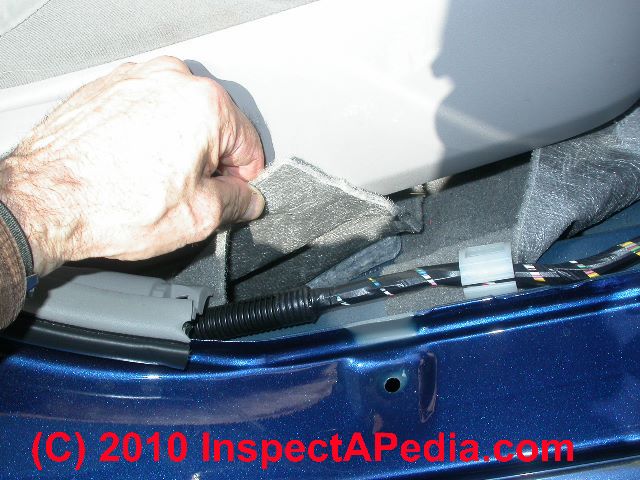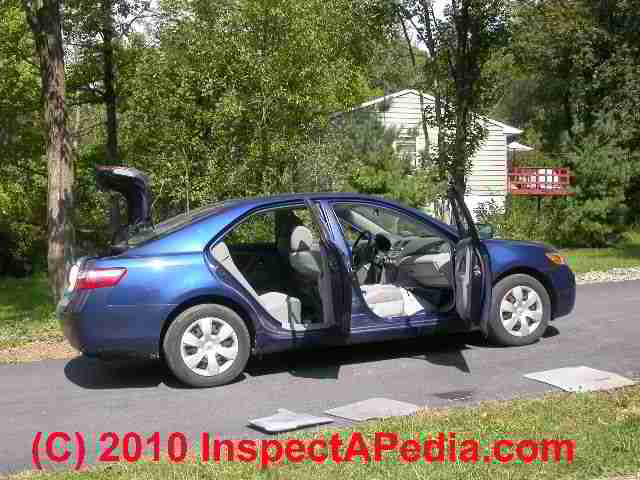 Moldy Car Smell Diagnosis & Cure
Moldy Car Smell Diagnosis & Cure
How to Find & Remove Mold and Moldy Odors in Cars, Automobiles, Trucks, Campers
- POST a QUESTION or COMMENT about removing mold and mold smells from cars, boats, campers, RVs, and other vehicles
Car mold or mildew odor diagnosis & cure procedure:
This article explains how to get rid of mold, mildew, or musty odors in cars, trucks, campers, boats, and similar vehicles.
We discuss the diagnosis of the cause of moldy or "mildew" smells in cars and other vehicles, how to track down the odor to its source, how to clean or remove the problem, and the importance of finding and fixing the leak that caused the smell in the first place.
InspectAPedia tolerates no conflicts of interest. We have no relationship with advertisers, products, or services discussed at this website.
- Daniel Friedman, Publisher/Editor/Author - See WHO ARE WE?
Car Odors - Mold: Boat, Camper, Car, or Truck Mold Contamination Can Cause Moldy Smells and May be a Health Risk
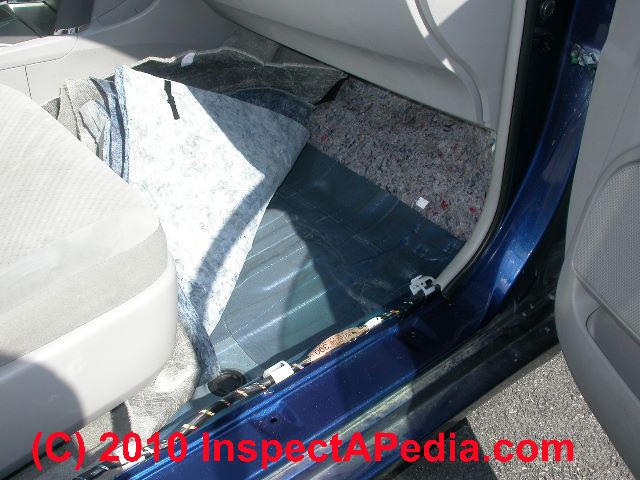 This article explains the causes and cures of moldy, musty or "mildew" smells in cars or similar vehicles, and how best to get rid of the offensive, unhealthy, or unsafe as well as obnoxious moldy odor.
This article explains the causes and cures of moldy, musty or "mildew" smells in cars or similar vehicles, and how best to get rid of the offensive, unhealthy, or unsafe as well as obnoxious moldy odor.
Article contents:
- AT RISK - MOLDY CAR OCCUPANTS
- COST OF CAR DEODORIZING
- STEP BY STEP CAR ODOR CLEANUP
- IDENTIFY THE SMELL
- CONFIRM SMELL IN VEHICLE
- TRACK STINK TO SOURCE
- FIND the STRONGEST SMELL
- REMOVE CONTAMINATED MATERIALS
- CHEMICAL CLEANERS, OZONE FOR CARS
- CAR DEODORIZE BY SUNLIGHT?
The photos above and at left show a nearly-new car that developed an unbearable mold smell traced to leaks at the passenger side window pillar.
Even though mold was not visible in the car interior and little mold was found in air and vacuum tests of the accessible vehicle surfaces, MVOCs from mold contamination in the leak area had produced a very strong musty "mildew" (actually mold) smell that required extensive cleaning and some material replacement to make the vehicle usable.
Details of this successful car deodorization process are included in this article.
Mold growth in a vehicle such as a boat, camper, car, or truck can be hard to see but easy to smell, producing an obnoxious moldy or musty smell that some owners refer to as car "mildew".
Usually a moldy smelling car that stinks as soon as you open a door to enter it, with the engine off, is due to a water leak and mold contaminated soft goods such as sound insulation, carpets, or even seats or the head liner. Don't forget to check the trunk for leaks and moldy smell sources too.
A moldy smell "mildew smell" coming out of the heating/cooling vents may be associated with mold growth inside the A/C evaporator itself according to Car Talk whose hosts suggested trying to "kill" the mold with Lysol spray.
In general we need to clean up or remove mold from problem areas; killing mold is ineffective, incomplete, and may leave harmful particles that continue to plague the car's occupants respiratory systems.
See MOLD KILLING GUIDE for details about attempts to kill mold in buildings - it also applies to cars. .
What you are actually smelling if you report a "moldy odor" is not necessarily air containing mold spores. You may be smelling MVOCs, gases produced by some mold species under some conditions. If we smell mold, is mold present and is that a problem?
Most people have a pretty good idea of moldy or musty smell as associated with mold. If you smell mold or find it at important levels in screening samples of air, dust, or vacuumed surfaces, (by quantity or by particle type in samples) it is probably there.
Or it was there. The moldy smell may persist even after the actual mold reservoir has been removed. That's because the volatile MVOC gases may have penetrated and been absorbed into other soft goods (car seats, headliner, carpeting) even if those items were not themselves ever wet or mold contaminated.
MVOCs themselves can be a respiratory irritant and might even be toxic to some individuals. We discuss MVOCs in more detail in our building hazards section
"At Risk" Moldy Car Occupants
A moldy car is more than an obnoxious-smelling vehicle in which to travel.
Watch out: For occupants who are at extra risk of respiratory or health problems such as asthmatics, elderly, infant, or immune-compromised people, exposure to high levels of mold, or of mold smells (MVOCs or mold volatile organic compounds) may be affected, possibly dangerously-so, even when there is no actual visible mold.
Check to see if the Car or Other Vehicle that Has Been Flooded
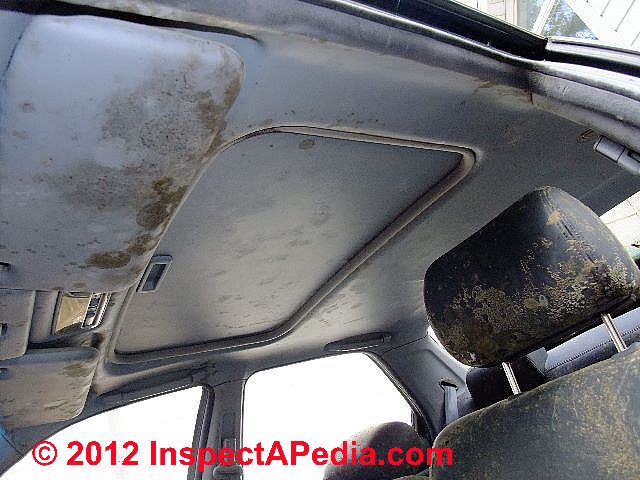 There are lots of clues that can help identify and protect you from buying a vehicle that has been flooded. Just below are some flooded car inspection highlights.
There are lots of clues that can help identify and protect you from buying a vehicle that has been flooded. Just below are some flooded car inspection highlights.
See FLOODED CAR DETECTION for complete details on how to inspect a car to detect prior flood or water damage: [8][9] Here is a brief summary of example points to check:
- Check the vehicle title
for flood-car branding. Cars or other vehicles that have been declared a total loss due to flooding bear a title indicating that the vehicle is a "flood car". - Check the vehicle identification numbers (VIN)
to see that the numbers you can find all match, and that they match the title. - Check for residues of mud, sewage, salt, debris
in cracks and crevices of the vehicle such as inside hood or trunk stiffening members (through access holes), inside rear-view mirror bases, in the battery tray, underneath glove compartment or door pocket compartment liners, and inside of electrical connector covers.
Look also inside of headlight or tail light covers. - Check for mold odors
inside the vehicle. With the vehicle's windows and doors closed (the longer the closed-up interval the better) notice if the interior smells moldy. - Check for strong plastic or chemical odors
inside the vehicle. - Inspect the upholstery,
head liner, carpeting for sagging, puckering; - Inspect carpets & headliners
or door liners or for traces of mud and rust below floor carpets and padding; take a close whiff of floor carpeting. - Inspect interior trim and plastic components
for signs of removal-replacement, such as screws whose head-slots have been gouged or damaged or missing, incomplete trim screws. - Look for moisture or condensation in headlights,
tail lights, other vehicle lights - Look for unusual or non-working electrical components;
test every electrical component or light on the vehicle; flood damage often leaves electrical components in disarray, not working, or incompletely or incorrectly replaced by hasty workers; - Look for salt corrosion on engine parts
under the hood; - Check the engine oil
for light brown froth after the engine has been run; water left in the crankcase from any source can cause this condition; - Ask for an independent, expert vehicle inspection
either from a mechanic you know and trust, or from companies who provide that service.
Cost of Removing Smelly Mold Odors from a Vehicle
The cost of successfully removing a moldy smell from a car ranges from low if you found and fixed a small problem early (wet smelly floor mats) to very high if the smell contamination is extensive and involves extensive car interior materials such as the seating and head liner.
If the vehicle interior is visibly moldy throughout, the car is, in our experience, likely to be a total loss. This is certainly likely to be the case for a car that has been under water, such as in a flood zone or hurricane. Don't get fooled into accepting a superficial "clean-up" job on such a vehicle.
Here is our step by step moldy or smelly car cleanup guide - how to get rid of both the mold and the mold smell in a vehicle
The most reliable to find and remove the source and cause of a moldy smell in a vehicle involves several steps. We list the car deodorizing steps, and following the list we discuss each of these car smell cure steps in more detail.
- Identify the smell in the vehicle:
is it mold or something else? Most people's opinion of "moldy smell" is spot-on. - Confirm that the moldy or "mildew" smell comes from inside the vehicle,
ruling out having simply parked in a stinky area. Confirm that it's a moldy smell identify the smell in the vehicle to be sure it's "moldy" and not something else such as the other vehicle odors discussed throughout our vehicle-odor diagnosis article:
BOAT & CAR SMELLS & ODORS - Rule Out Indirect Odor or Smell Sources:
Track the Stink to the Source, by ruling out odors that seem to be coming from a vehicle but actually come from an indirect source such as a boat cover, parking in a smelly area, etc. - Find where in the vehicle the smell is strongest. Use the subjective test of a smell-test person, or if necessary, use
our SMELL PATCH TEST to FIND ODOR SOURCE to confirm that the odor source is a specific item such as car carpeting, sound insulation, seat, or headliner. - Look for and trace the source of water leaks into the vehicle. Mold needs water to grow, and food to eat - carpeting, plastic surfaces, cloth head liners, sound insulation, even paint will do. Mold does not grow on clean metal surfaces in a car.
- Remove moldy, smelly materials
such as moldy carpeting or seats, clean the remaining car interior, and repeat the steps above. The moldy smell should be significantly less. It probably won't be completely gone, because the mold odor-source - the MVOCs that you were actually smelling, is a gas that also permeates other porous vehicle materials. - Use "odor-killing" deodorants or ozone to get rid of moldy car smell?
Generally we do not recommend car deodorants - they only cover up the smell, the do not get rid of the source. It will be back.
Watch out: as we warn again below, Ozone generators produce ozone gas, a strong oxidant (and dangerous to breathe) that temporarily fills the car interior to try to "oxidize" or "kill" mold that your car cleaning company couldn't reach - such as sound insulation padding up high inside the front fire-wall of the car, under the dash board.
Be very careful if you're going to permit someone to ozone-treat your car. If the ozone treatment is over-done, the ozone can oxidize other car materials, causing a more horrible odor than ever. - Let the cleaned vehicle "cook" in sunlight
on warm, dry days, with the car windows open. - If the boat, car, camper, truck, or other vehicle still smells
as bad as before, you have not found the source and you'll need to be more aggressive in finding and removing smell-contaminated materials. Go back to step 1.
These car mold removal steps are discussed in detail below.
Identify the Smell in the Vehicle: is it Mold or Something Else
Most people are pretty accurate in recognizing a musty, "mildew" odor or moldy odor indoors or inside of a car. To be technically accurate, mildew, a smaller group of mold types, grows only on living plants and not in cars. If it smells moldy, it's mold (not mildew).
But because tackling a moldy car smell can be difficult, expensive, and frustrating, it would be smart to be sure we're fighting the right battle before beginning to tear the boat, car, camper, or truck apart to find and get rid of moldy materials.
Confirm That the Moldy or "Mildew" Smell Comes From Inside the Vehicle and Look for Visible Mold
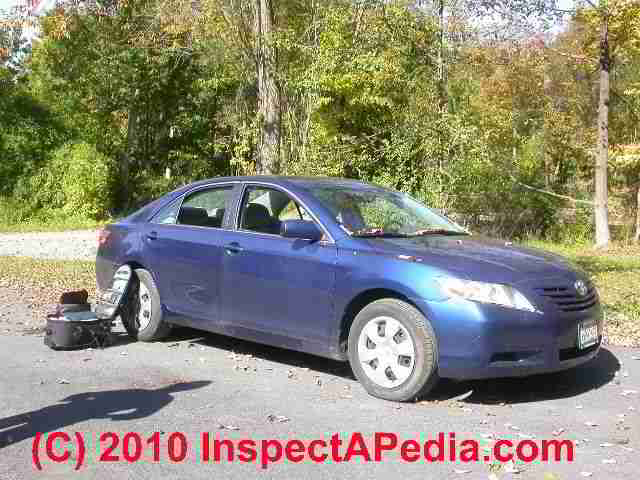 To confirm that the smell is indeed coming from inside the car, and that it's a moldy smell, begin with the car with engine off, the vehicle washed clean, including the under-carriage, (you weren't out driving through a manure-covered barnyard first were you?).
To confirm that the smell is indeed coming from inside the car, and that it's a moldy smell, begin with the car with engine off, the vehicle washed clean, including the under-carriage, (you weren't out driving through a manure-covered barnyard first were you?).
Should you test your car for toxic mold contamination? No.
Not normally. Smelling and looking for mold in a vehicle should be sufficient, and you would not normally need to actually test a car for toxic or allergenic mold contamination.
In our photo (left) you can see our field test kit for mold at the smelly-car's rear corner. For the owners, we performed a series of pro-bono mold tests on this moldy-smelling car in preparing this article.
We tested the vehicle air for abnormal levels of airborne mold and we collected vacuum samples of dust from the vehicle's carpets and padding to look for evidence of problem mold contamination.
We did not need to test for MVOCs - smelling the car was enough.
Our mold test lab photos (below) show examples of what we found in our carpet dust samples from this moldy-smelling car: dog hair, dog dander, cat dander, dust mite fecal pellets, road dust and dirt, incidental plant fragments, and occasional typical outdoor airborne mold spores.
We also found a some starch granules and some yeast cells, possibly associated with food spillage. There was no significant visible mold spore contamination in the sampled areas.
See CAT DANDER in BUILDINGS for a general discussion about pet allergies and dander.
The contamination was by a moldy smell - MVOCs from mold that more likely had occupied harder-to reach areas under the dashboard.
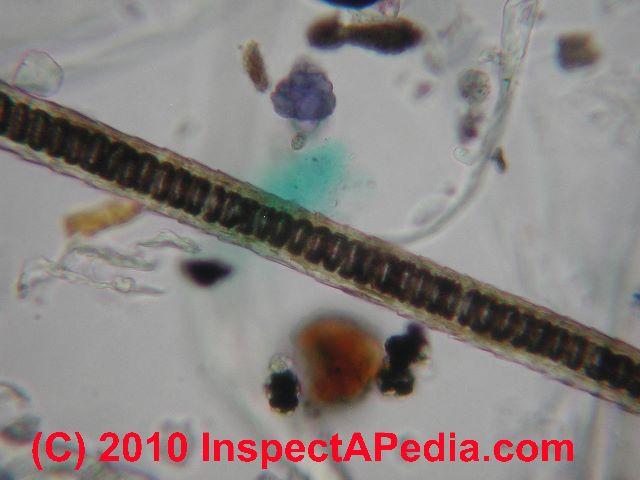
How to smell-test a car for mold: Close all of the vehicle windows, doors, hatches.
Let the vehicle sit in the sunlight until its interior is warm. On a summer day this may require just a half hour or so.
Select your smell-test person, someone who is particularly sensitive to mold, such as your wife or girl friend. (Make sure she's not one of the at-risk people we've described above.)
Women usually have a keener sense of smell than men, and we have found that pregnant women sometimes have an extremely sensitive ability to detect odors. However we think that exposing pregnant women to possibly moldy cars or any other obnoxious stuff is a not good idea.
Have the smell test person approach the car, breathing normally. Starting with the door closest to where you already think the mold smell is strongest, open the door, quickly slide into the seat, and close the door.
Take a whiff of the smelly car interior. Get out of the car and close the door again.
Report the results: did the car smell moldy? How bad was it?
Rule Out Indirect Odor or Smell Sources: Track the Stink to the Source
If your smelly vehicle is an RV, camper, or boat, check that the moldy odor source is not coming from an indirect source such as a moldy boat cover or RV cover. If your boat or RV cover contains plastic or vinyl,
see VINYL SIDING or WINDOW PLASTIC ODORS as an example of that material as a potential odor source in buildings; odors from hot vinyl in cars are a similar phenomenon..
Parking a vehicle in a smelly area, over manure or over a dead animal, or covering a vehicle with a moldy canvas or vinyl car cover are examples of indirect car smell sources.
Other examples of tracking down indirect odor sources are provided
at DUCT & AIR HANDLER ODORS (duct work picking up and transporting odors from one place to another in a building - this can happen in a car too),
and at ODOR DIAGNOSIS CHECKLIST, PROCEDURE - our list of steps to track down a smell in a building. Some of the strategy discussed there, such as noticing the time of day, weather conditions, etc. may help track down a smell in a car.
Find where in the vehicle the smell is strongest
Often the moldy smell is stronger in one area of the vehicle.
In the moldy car case used as an example in this article, the strongest moldy smell was observed in the front passenger compartment.
Our photo above shows the peeled-back floor carpeting in the moldy-smelling car's front passenger area.
This car was nearly new and things looked clean, but carpeting, padding, and sound insulation extending up under the dashboard had been wet in this area - the primary odor reservoir in this vehicle.
If necessary, have the smell-tester repeat this procedure for the other car seats and doors, waiting five or ten minutes in fresh air between each test.
Beware: your test results can be thrown off: repeated or prolonged exposure to a moldy smell makes many people become less sensitive to the odor, potentially making their report unreliable if the smeller does not wait long enough in fresh air between smell-tests of the vehicle.
If necessary, use our simple and inexpensive smell patch test to confirm that the odor source is a specific item such as car carpeting, sound insulation, seat, or headliner.
Details are at SMELL PATCH TEST to FIND ODOR SOURCE.
Our photo (left) shows how we create a smell patch test to isolate odors to a specific area or material.
Foil is taped over a clean folded paper towel placed on the test surface, left for 24 hours, then rapidly removed, the towel is balled in the foil, and the assembly is quickly taken outside into fresh air for a sniff test to compare the level of smell from different areas.
This procedure is often very accurate at pinpointing smell to a particular surface.
Look for and trace the source of water leaks into the vehicle
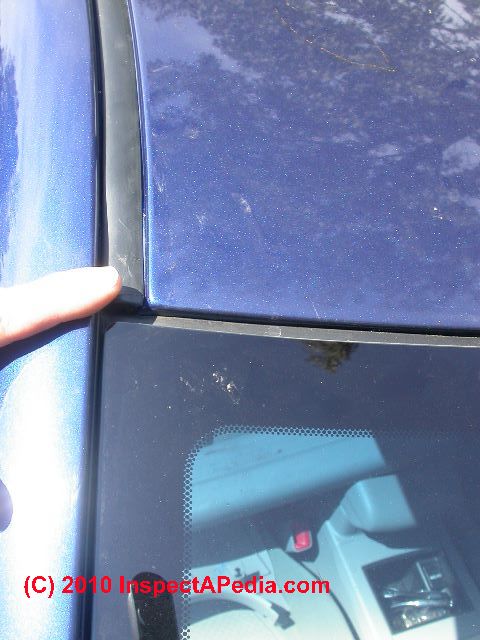
It is essential to find and cure the cause of a moldy smell in a vehicle - otherwise the entire diagnostic, cleaning, and testing process will be wasted.
In the moldy car case used as an example in this article, a water leak at the front passenger side windshield pillar was sending water down inside the pillar into the area behind and under the dash board on the passenger side, ultimately onto the passenger side floor.
The car's owners first noticed the leak problem as a wet floor mat. On exploring they found that carpeting below the floor mat was still more wet. This meant trouble.
In our photo (left) the author points to the very origin of the roof and windshield pillar leak on the car's passenger side. The dealer was able to trace the leak to its source, and the leak was repaired. But the moldy smell remained.
Remove moldy materials from the Vehicle
Getting rid of a moldy smell in a vehicle means first, removing the wet or moldy materials that are the home of the stink. The proper approach to cleaning out a mold problem is to remove the mold. Approaches that focus on "mold killers" or mold deodorants are ineffective.
But how much smelly, moldy, or previously wet material needs to be removed? We did not have to remove the rear carpets in this case.
Our photos (above & below) show the inspection of rear carpeting where it terminated under the front passenger seat.
We looked for evidence of wetness having extended back to the rear floor of the car, such as moisture or stains.
Remember that if you are checking for leaks and moisture in dry weather, the wet carpeting may have dried out and may look just fine.
Smell it and look for water stains.
Carpeting, seats, sound insulation, head liners, door liners, or other vehicle materials that have actually been soaked and that smell moldy need to be removed and disposed-of, and the exposed surfaces of the vehicle cleaned using conventional cleaners (soap and water would be fine).
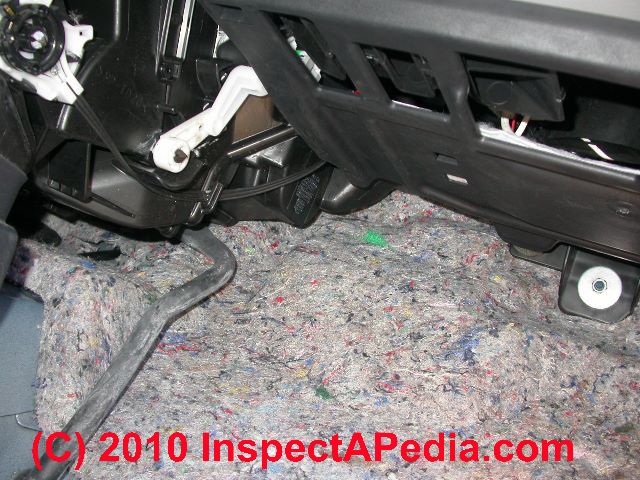 Our photo shows the primary smell reservoir in this mold-stinky car: the carpet padding and sound insulation material. A topic of considerable discussion was just how much of this padding to remove.
Our photo shows the primary smell reservoir in this mold-stinky car: the carpet padding and sound insulation material. A topic of considerable discussion was just how much of this padding to remove.
Ideally all of the padding that had been wet would have been pulled from the car.
The problem, explained by the car dealer, was that that this padding extends up under the dashboard, higher than can be readily pulled out from inside the car, unless the entire dashboard assembly is first removed.
Our opinion and possibly that of car experts Click and Clack the Tappet Brothers (NPR) is that we do not ever want to have the dealer remove the car's dashboard if we can possibly avoid it. Too often wires and connections are not properly restored, and electrical, control, and maybe other problems may plague the car for the rest of its life.
The owners heeded this advice and compromised on the mold deodorizing process. Sound insulation was pulled out and removed completely, for "as far as the dealer's service tech could reach" without removing the dashboard.
The decision, which is one with which we agree, to leave the dash board in place might explain why after all the removal of smelly padding and carpeting, it took quite some time for the remaining moldy odor to nearly disappear from the car.
Nearby porous materials such as the vehicle's head liner that were never wet but that have been exposed to moldy odors may continue to smell even after the original smell source has been cleaned.
Sometimes, a combination of cleaning, sun-cooking with windows open, and the passage of time will dissipate the remaining MVOC-related moldy smell from these secondary smell reservoirs, enough that the vehicle is usable. If not, additional materials may need to be removed.
Two additional moldy car smell deodorizing steps are described next.
Can I Use "odor-killing" chemicals, deodorants, or ozone to get rid of moldy or other bad car smells?
Generally we do not recommend car deodorants - they only cover up the smell, the do not get rid of the source. It will be back.
Ozone generators produce ozone gas, a strong oxidant (and dangerous to breathe) that temporarily fills the car interior to try to "oxidize" or "kill" mold that your car cleaning company couldn't reach - such as sound insulation padding up high inside the front fire-wall of the car, under the dash board.
Watch out: Be very careful if you're going to permit someone to ozone-treat your car. If the ozone treatment is over-done, the ozone can oxidize other car materials, causing a more horrible odor than ever.
Details about over-dosing with ozone are found
at OZONE MOLD / ODOR TREATMENT WARNINGS.
"Chemical Cleaner" followed by "Ozone Overdose" Ruins Car?
Field Report: Unsuccessful Try at Removing Car Odors:
Question: The Dealer's Attempt to Deodorize a smell in my car's A/C vent system made things much worse. Is it safe?
I took my automobile to a Chrysler dealer to have the evaporator (AC vent system ) cleaned due to a bacteria/mold smell which I was told is common in Chrysler products.
The dealer used a chemical “cleaner” which on the market which was supposed to remove this material. It apparently worked however I was left with a terrible perfume-like odor that would not go away.
This went on for a few weeks until they finally had a company come in and ozone treat the interior.
I need to point out I have severe emphysema and asthma.
The individuals there at the dealership including the service man from the company all said the equipment was used “over the weekend” for an extended period of time to remove the perfume smell and allowed to run over the weekend.
They used 2 ozone generators inside the car: one in the trunk and one in the interior cabin area.
The “expert” from the cleaning company said what he smells is “CLEAN AIR” – MY REPLY IS SIMPLY BULL.
NOW I have a serious odd “chemical odor” in the car which is more (and then some) irritating than the perfume odor.
This smell has now persisted for over 30 days now with the car left running with the AC and fans running, sitting in an open area with the windows down and so on, they even cleaned the upholstery and rugs.
Question is what the dickens is going on?
Is my car ruined due to ozone treatment?
Has a chemical reaction started or occurred? And most significant is this dangerous? I need to get rid of the Auto but cannot dump a car on someone that may he harmed by this odor!
Please advise me about what has happened here! - M.R.
Reply: It may have been less expensive and more effective to do it right the first time.
OPINION: With just an email naturally no one can accurately diagnose nor cure an odor problem nor really assess its level of risk, but here are some thoughts based on our experience and your report:
What you describe does not sound like the most effective approach to a car odor and worse, as if it has indeed made things worse. We can only guess from so little info, but
- Chemical deodorants for cars?
It is common for people to try to "treat" an unwanted odor by using (by spray or other means) a "deodorant" chemical (perfume?) that does not actually remove anything.
Rather it superimposes a new odor that drowns out or disguises the old one. "Air fresheners" often work this way.Because under continued exposure our brains eventually tune out odors or smells - at least to some degree - the perfume deodorant is first covering up and then desensitizing the human being's nose rather than removing or cleaning up a problem.
This is not so horrible if the original problem was not health related, though not effective as it does nothing about finding and removing the original odor problem.
In this case the original odor may later return, or if it's a "new car smell" or an odor from new materials it may eventually out gas, dissipate, and thus become much less noticeable.A related problem is that some people are or become sensitive to the new "deodorant" chemicals themselves, suffering from asthma attacks or other complaints.
- Shampoo plus chemical deodorant?
A similar approach to car odor reduction is to wash or shampoo carpets or seats hoping that that step removes an odor problem (if those materials were even the original problem source), combined with an odorant or "air sanitizer" chemical as we described above. - Heavy dosing a car interior with with ozone,
as you describe, risks oxidizing plastics and fabrics inside the automobile, making a new horrible smell that frankly, is unlikely to go away unless the car is gutted.Worse, the odor from an oxidized material, say a carpet, often penetrates and is absorbed into other materials such as a headliner or seats, so we no longer have the option of just replacing the smelly oxidized carpet, seats, or whatever the offender is.
The new odors are themselves respiratory irritants to some people, especially people who are chemically sensitive, asthmatic, etc.
The new odor is not going to be ozone itself (which is certainly dangerous at high levels) because ozone is so volatile that it doesn't stick around long after the ozone generator machine has been turned off. Rather the new odors are, in our experience, from oxidized materials in the car. We don't know the actual risk in any given case as individual sensitivity varies widely.
See details at OZONE MOLD / ODOR TREATMENT WARNINGS
These reasons are why, even though it sounds like a lot more trouble, it is actually often more effective and less expensive to find and remove the original odor source in the first place, along with finding and fixing its cause.
Now, we are afraid, it may be too late for this car and it might have been rendered unusable. And we agree that what you smell is certainly not "clean air" - if the air in the car were clean - odor free - it would not smell.
Before giving up on the overdosed, over-ozoned car
you can try the next suggestion we list below:
Air out the car and let it bake in the sun with its windows open (and watch out for rainstorms). Otherwise, to restore the car now may require identifying just what in-car components are smell sources, they have to then be removed, the car aired-out, and new materials installed. These might include:
- Car carpets
- Car seats
- Car headliner
- Car door liners
- Car sound insulation padding
- Trunk carpeting or sound insulation padding
We do not advise just passing on the car to someone else before these problems are fixed - you wouldn't want to be responsible for some future car-occupant's health or respiratory problem that might be caused, contributed to, or blamed-on the smelly car.
Let the Cleaned Vehicle "Cook" in Sunlight
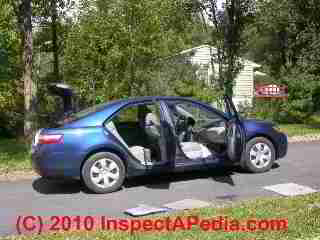
On warm, dry days, with the vehicle's windows open, or if it's a boat, with any covers removed, expose the vehicle to full days of sunlight and fresh air.
In the moldy car case used as an example in this article, a combination of removal of smelly carpeting and sound insulation from the front of the vehicle, combined with cleaning and deodorizing, left the car with a slight moldy odor that we could just barely detect eight months after the cleanup began.
The owners were satisfied.
If Your Boat, Car, Camper, Truck, or Other Vehicle Still Smells Moldy
If the vehicle still smells as moldy as before, you have not found the source and you'll need to be more aggressive in finding and removing smell-contaminated materials. Go back to step 1.
Also see our details about wet, moldy, smelly carpeting
at CARPET MOLD / ODOR TESTS where we describe ow to diagnose & cure carpet smells due to mold, mildew, pet urine,
and try this CARPET CONTAMINATION TEST PROCEDURE
...
Reader Comments, Questions & Answers About The Article Above
Below you will find questions and answers previously posted on this page at its page bottom reader comment box.
Reader Q&A - also see RECOMMENDED ARTICLES & FAQs
Can I remove mold from inside my car?
can mold be removed totally from a car interior and how - On 2011-08-12 by marialara01@aol.com
Reply by (mod) - it is indeed possible to remove problem mold from a car interior, Sometimes
Maria, it is indeed possible to remove problem mold from a car interior, but the key is finding the leak that caused the mold, and determining what car materials have become mold contaminated.
A really troublesome problem is getting rid of mold odors in a car that has been mold contaminated, as MVOCs emitted by some molds seem to penetrate and remain in upholstery, carpeting, headliners, and sound deadening insulation.
In some cases we've investigated there have also been horrible SNAFUs when folks over-did an ozone treatment of the car interior, making matters worse and the car unusable.
See CAR SMELL - Mold DEODORIZING
There we give in depth information about dealing with mold and mold odors in car interiors.
And read CAR MOLD CONTAMINATION
Don't hesitate to ask again if you're left with questions about getting rid of mold or mold odors in a vehicle.
...
Continue reading at OZONE MOLD / ODOR TREATMENT WARNINGS or select a topic from the closely-related articles below, or see the complete ARTICLE INDEX.
Or see CAR SMELL - MOLD DEODORIZING FAQs - questions & answers posted originally at the end of this page
Or see these
Recommended Articles
- BOAT & CAR SMELLS & ODORS
- BLEACHING MOLD, Advice
- CAR MOLD CONTAMINATION
- CAR SMELL - MOLD DEODORIZING
- CARPET MOLD / ODOR TESTS
- CARPET PADDING ASBESTOS, MOLD, ODORS
- FLOODED CAR DETECTION
- OZONE MOLD / ODOR TREATMENT WARNINGS
- SMELL PATCH TEST to FIND ODOR SOURCE
- CAR SMELL - MOLD DEODORIZING
- CAR SMELL & ODOR DIAGNOSIS
- CAR / TRUCK AC PRESSURE SWITCH
- CARPET AIR LEAK STAINS at WALLS
- CARPET CONTAMINATION TEST PROCEDURE
- CARPET MOLD / ODOR TESTS
- CARPETING & INDOOR AIR QUALITY
- DUCT & AIR HANDLER ODORS
- MVOCs & MOLDY MUSTY ODORS
- ODOR DIAGNOSIS CHECKLIST, PROCEDURE
- OZONE MOLD / ODOR TREATMENT WARNINGS
- VINYL SIDING or WINDOW PLASTIC ODORS
Suggested citation for this web page
CAR SMELL - MOLD DEODORIZING at InspectApedia.com - online encyclopedia of building & environmental inspection, testing, diagnosis, repair, & problem prevention advice.
Or see this
INDEX to RELATED ARTICLES: ARTICLE INDEX to BUILDING ODOR DIAGNOSIS & CURE
Or use the SEARCH BOX found below to Ask a Question or Search InspectApedia
Ask a Question or Search InspectApedia
Questions & answers or comments about removing mold and mold smells from cars, boats, campers, RVs, and other vehicles
Try the search box just below, or if you prefer, post a question or comment in the Comments box below and we will respond promptly.
Search the InspectApedia website
Note: appearance of your Comment below may be delayed: if your comment contains an image, photograph, web link, or text that looks to the software as if it might be a web link, your posting will appear after it has been approved by a moderator. Apologies for the delay.
Only one image can be added per comment but you can post as many comments, and therefore images, as you like.
You will not receive a notification when a response to your question has been posted.
Please bookmark this page to make it easy for you to check back for our response.
IF above you see "Comment Form is loading comments..." then COMMENT BOX - countable.ca / bawkbox.com IS NOT WORKING.
In any case you are welcome to send an email directly to us at InspectApedia.com at editor@inspectApedia.com
We'll reply to you directly. Please help us help you by noting, in your email, the URL of the InspectApedia page where you wanted to comment.
Citations & References
In addition to any citations in the article above, a full list is available on request.
- [1] "Health effects of a mold-contaminated automobile", J. Santilli, W. Rockwell, W. Vaughn, Journal of Allergy and Clinical Immunology, Volume 113, Issue 2, Page S59. Quoting abstract:
Most reactions to indoor mold exposure have been reported from mold-contaminated homes, office buildings or schools. We report a patient who experienced symptoms from exposure to a contaminated air-conditioner in her automobile. ...
This case demonstrates that we should be testing work environments, homes and schools for mold contamination and must now add automobiles to our testing regimen where indicated. - [2] "Mold contamination of automobile air conditioner systems", Kumar P, Lopez M, Fan W, Cambre K, Elston RC., Ann Allergy. 1990 Feb; 64(2 Pt 1):174-7. Department of Medicine, Louisiana State University Medical Center, New Orleans. Abstract:
Eight cars belonging to patients who were found to have exacerbation of allergic rhinitis and bronchial asthma after turning on the air conditioner in their cars were examined ...Furthermore, placement of a filter at the portal of entry of outside air significantly reduced the mold concentration in the passenger compartment. - [3] ASTM E2600 - 08 Standard Practice for Assessment of Vapor Intrusion into Structures on Property Involved in Real Estate Transactions is available from the ASTM at astm.org/Standards/E2600.htm .
"This practice is intended for use on a voluntary basis by parties who wish to conduct a VIA on a parcel of real estate , or more specifically conduct a screening evaluation to determine whether or not there is potential for a VIC, and if so, identify alternatives for further investigation."
The standard goes on to emphasize the uncertainty in testing any site for gases and vapor intrusion. - [4] "Shaky Seats, Leaky Fluids, Toyota" Scott Sturgis, The New York Times, 01/24/2010, Automobiles section, p. 4.
- [4] Thanks to B.L., Poughkeepsie, NY, for discussion of the cause and cure of moldy car smells and permission to take and use photos of the family's moldy car during its mold deodorizing procedure, 2009.
- [6] Thanks to M.R. for discussing an ineffective attempt at deodorizing a smelly car - November 2010
- [7] Click and Clack the Tappet Brothers, is the nom-de-radio for NPR's Car Talk radio program hosts Tom and Ray Magliozzi, who can also be contacted by telephone at 888-227-8255. An online discussion of the detection, cause, and cure of smells or mold in cars, reviewing this InspectAPedia article has been opened at Car Talk at http://action.publicbroadcasting.net/cartalk/posts/list/2136105.page
- [8] Darah Maslin Nir, "Dried Out and Title-Scrubbed, Flooded Cars Lure the Unwary", The New York Times, 13 January 2013, p. 1
- [9] Andy Gieseke, Canyon Auto Sales, 3500 N. 1st Ave., Tucson AZ 85719, Tel: 520-293-3324
- In addition to citations & references found in this article, see the research citations given at the end of the related articles found at our suggested
CONTINUE READING or RECOMMENDED ARTICLES.
- Carson, Dunlop & Associates Ltd., 120 Carlton Street Suite 407, Toronto ON M5A 4K2. Tel: (416) 964-9415 1-800-268-7070 Email: info@carsondunlop.com. Alan Carson is a past president of ASHI, the American Society of Home Inspectors.
Thanks to Alan Carson and Bob Dunlop, for permission for InspectAPedia to use text excerpts from The HOME REFERENCE BOOK - the Encyclopedia of Homes and to use illustrations from The ILLUSTRATED HOME .
Carson Dunlop Associates provides extensive home inspection education and report writing material. In gratitude we provide links to tsome Carson Dunlop Associates products and services.


